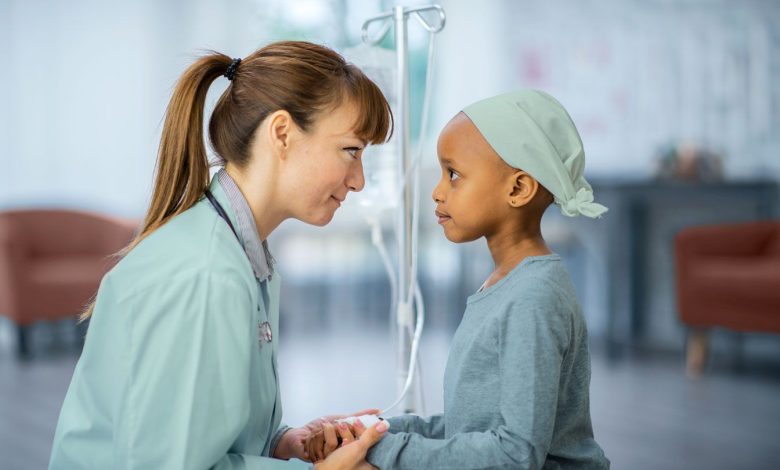What to Do if Your Child’s Leukemia Comes Back

[ad_1]
If there are symptoms, they may be similar to what children felt when they were first diagnosed. “Certain patients may experience high fevers, back pain, or limping,” says Branko Cuglievan, MD, an assistant professor and section chief of leukemia-lymphoma in the department of pediatrics patient care at The University of Texas MD Anderson Cancer Center in Houston. This may compel “vigilant parents to seek prompt medical attention for their children’s concerns.”
Symptoms of leukemia recurrence also include other unexplained body aches, fatigue, a pale appearance, decreased playfulness, excessive bruising or bleeding, swollen lymph nodes, and difficulty breathing, says David Dickens, MD, a professor of pediatrics and clinical director of pediatric oncology services at the University of Iowa Health Care in Iowa City.
Learn About Treatment Options
Once the disease has gone back into remission, the goal may be to perform a bone marrow stem cell transplant, depending on the type of leukemia, says Dr. Rotz.
Understand Your Child’s Prognosis
While “relapsed leukemia is very serious,” Rotz adds that “many new promising therapies are available.” As a result, “the prognosis can be good for many, but it isn’t good for everyone — and prognosis may vary drastically based on individual circumstances.”
Prognosis depends on a number of factors, according to Dr. Dickens, including the following:
- The exact type of leukemia
- The timing of the relapse (how soon after the original diagnosis the relapse occurs)
- The location of the relapse (bone marrow, brain or spinal fluid, testes)
- The genetic mutations of the leukemia
- The number of recurrences
- The response to therapies given after the leukemia has failed to respond to standard therapy, also known as rescue therapy or salvage therapy
“Depending on that information,” Dickens says, “the prognosis can widely range from nearly incurable to about a 60 percent cure rate.”
Dr. Cuglievan notes that “in cases of B-cell ALL, there remains optimism for a cure, as groundbreaking therapies like immunotherapies and CAR T-cells are reshaping the landscape of leukemia treatment. For T-cell leukemia, encouraging data on CAR T-cells exists, though broader studies in the population are eagerly awaited.”
Meanwhile, “AML outcomes can generally be unfavorable, but prolonged initial remission opens avenues for salvage [therapy],” says Cuglievan. “Specific genetic subtypes benefit from [new] therapies that are revolutionizing treatment approaches.”
Choose a Path Tailored to Your Child
With the initial diagnosis, there is typically a much more standardized approach, but treatment for recurrent leukemia can vary, says Burns.
“Families should feel well informed by their medical team of what their options are,” she says, and should ask the following:
- Is there a standard treatment?
- Would it differ if our child was being treated at another institution?
- Are there clinical trial options that we should consider?
To help decide on the best treatment for your child, Burns suggests asking about what new information or novel testing may be available.
“Every family and every child is unique, and what might make sense to one family may not align with the goals or values of another,” she says. “So, there shouldn’t be a one-fits-all approach to treatment, and families should feel comfortable with what is ultimately decided.”
Experimental drug trials are more important to consider for a patient with a very poor prognosis, very early relapse, or multiple relapses, says Dr. Boelens. If no trials are available where your child is undergoing treatment, he suggests asking if other hospitals or cancer centers offer them. In evaluating whether to pursue a trial, it helps to ask about the facility’s experience with your child’s specific condition.
Find Support Along the Way
Boelens also recommends seeking out child life specialists at the treating hospital. He would advise parents to encourage their child to talk with a child psychologist, a psychologist who deals specifically with pediatric oncology, or a pediatric social worker. “These people and roles are equipped to support the child, family, and caretakers and provide them with tools to deal with their new reality,” he says.
Cayden, who was diagnosed at age 3 in April 2020, completed treatment in April 2022 but relapsed in February 2023. The second time, he needed chemotherapy, the targeted immunotherapy agent blinatumomab (Blincyto), and CAR T-cell therapy. He’s now awaiting a match for a bone marrow transplant.
Throughout the ordeal, Addison has turned to family, friends, hospital staff, and the Leukemia and Lymphoma Society for support. The organization led her to develop “an instant connection” with other parents of children with leukemia; only they truly understand how it feels to walk in her shoes.
“From the first moment, you immediately know their deepest pain, their deepest heartache,” says Addison. “I found that I could talk more freely about the emotional struggles. All of these support systems are critical to help you through this journey.”
While going through treatment for a relapse of leukemia is more difficult than initial therapy, children and their families “are capable of recovering from the physical, emotional, and psychological trauma,” says Dickens. “They already did all that the first time around. Kids are resilient and born to survive. Where there’s life, there’s hope.”
[ad_2]




